A guitar with 12 strings has 6 paired rows of strings that can be tuned in unison or in octaves.
The best 12-string guitar produces a thick, ringing sound that allows creating the most complex musical compositions. For this reason, it was used by numerous iconic bands (Queen, The Smiths, The Beatles, R.E.M., Led Zeppelin, and others).
Supposedly, the first guitar with 12 strings appeared at the end of the 19th century. It became popular in the early 20th century, mainly among jazz players. However, since the 70s-80s and until nowadays, such guitars are widely used among alternative rock, pop, and indie guitarists.
Two rows of strings always create a flickering effect because even when strings are tuned to play in unison, they can never vibrate identically. This results in the creation of a chorus effect. Some musicians also think that the 12-string guitar sounds slightly out-of-tuned. Its sound is also considered as highly dynamic: the interference between out-of-phase vibrations creates a periodic increase and decrease in intensity. In comparison with a usual 6-string guitar, its sound also differs by its richness and is considered as more melodic and more voluminous.
The 12-string guitars aren’t recommended for those who are just learning to play the guitar: it can be physically difficult to play and definitely not easy to tune. This way, it’s suitable for experienced players, professionals, and those who want to level-up their playing. It also may be a great solution for those musicians who are desperate to find new sounding as the 12-string guitar is considered non-standard. Thanks to the increased number of strings, it offers more opportunities for your musical ideas. Each pair of strings is usually combined during playing, but you can separate them (however, this requires significant skills).
Before placing an order, it’s better to make yourself aware of the most decent models on today’s market to choose the best 12-string guitar. Our top choices are here to help you with this.
12-String Guitar Reviews
Fender CD-60SCE-12
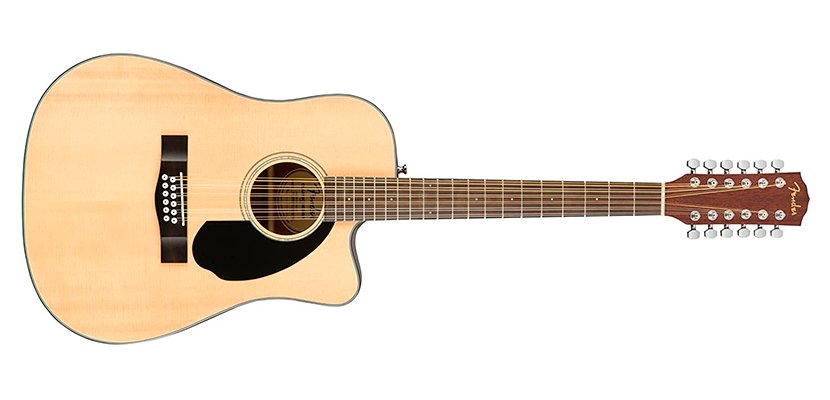
This Fender 12-string guitar has a light-colored wood finish, boasts solid dreadnought body, and can function as both electric and acoustic models.
The guitar’s construction includes a cutaway which allows for easy access to the upper part of the fret. The top with X-bracing is made of spruce which enhances volume and makes the sound crispier. The back and sides are made of mahogany. The area around the soundhole has an acrylic design.
The sound of the guitar is remarkable for a high level of brightness and wide dynamic range which responds well to almost any playing style from strumming to gentle fingerpicking. Thus, this model is worth being called the best 12-string acoustic guitar in terms of versatility.
Except for active preamp which amplifies your performance, the guitar is also equipped with Fishman electronics. The control panel on the right side of the instrument allows adjusting bass, volume, and treble. It’s also accompanied by a tiny digital display.
The all-in-one accessory kit of this Fender 12-string electric guitar deserves special attention. You will get such accessories as a hardshell case, extra strings, cloth, pickups, and strap. There is also a DVD with instructions that will help you get along with the CD-60SCE-12 quickly. The most unique thing in this kit is the digital clip-on tuner which allows for precise and easy tuning.
Pros
- Often, 12-string guitars don’t hold their pitch well but not this one.
- The neck has an easy-to-play shape.
- Low string action allows for easy playing.
Cons
- The quality of lamination seems poor.
- The included case is too bulky for transportation (much bulkier than the guitar itself).
- The guitar lacks the clarity of individual notes.
Video Fender CD-60SCE-12
Yamaha FG820
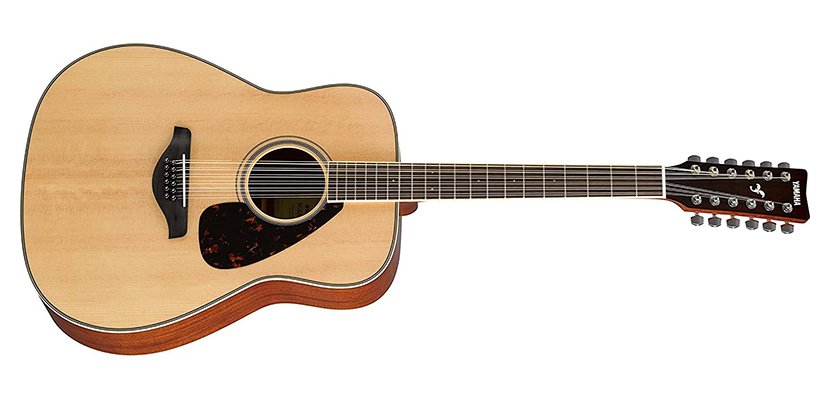
This 12-string acoustic guitar from Yamaha is offered in a wide array of different colors: turquoise, autumn burst, black, natural, brown sunburst, and sunset blue.
It’s a pretty straightforward model with a non-cutaway dreadnought body that doesn’t offer any specific features but allows playing without much tinkering. Thus, it will be suitable for those who are just beginning to get acquainted with 12-string models.
In terms of built quality, the fingerboard and the bridge of this twelve-string guitar are made of rosewood while back and sides are made of mahogany. It gives a well-balanced tone which will be especially appreciated by strummers. The mahogany also enhances midrange frequencies while the top end still remains clear. Instead of standard spruce, the solid Sitka spruce is used to make the guitar top. It’s able to ensure a well-rounded and articulate sound with great projection.
This guitar is equipped with a nato neck which is a rather cheap material and is considered as poor-quality material by some guitarists. However, I don’t think that it spoils anything. The guitar’s fingerboard is made of cream plastic which is not a high-end material as well.
The bracing has a scalloped pattern. Thanks to that, the top board is more durable and the guitar has more natural-sounding in general. It also increases the low end and creates rich, harmonic overtones in the mid-end.
In general, the sound of this guitar is soft and smooth and will show its greatest results playing country and blues.
Pros
- The guitar has a great combination of high-quality materials and firm construction.
- Despite big dimensions of the instrument, the sound still remains warm.
- The gentle and full sounding makes this guitar great for vocal accompaniment.
Cons
- Won’t work well for those searching for high-range sound.
- The strings don’t seem to be high-quality and may need a replacement for onstage performances.
Video Yamaha FG820
Oscar Schmidt OD312CE-A-U
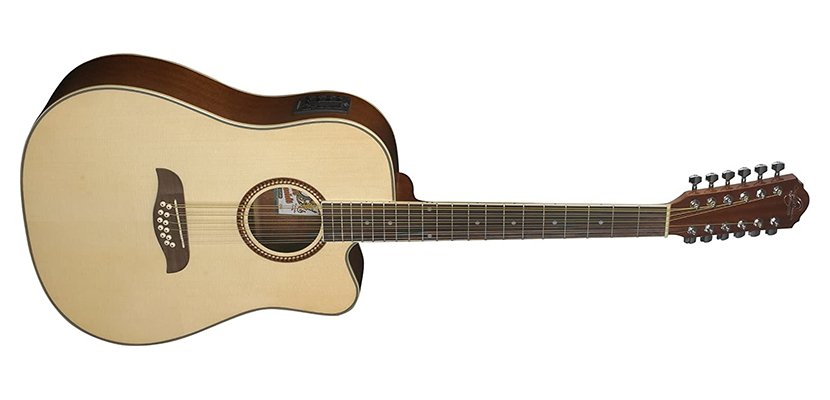
Oscar Schmidt is a manufacturer known for creating high-quality instruments that work great for folk music, and the OD312CE-A-U is not an exception. This low-action 12-string acoustic-electric guitar is available in one of three classic color choices: black, natural wood, and tobacco sunburst.
The guitar features decorative wood marquetry which gives it an authentic look and has a dreadnought body with a cutaway for easy upper fret access. Most of its parts are made of mahogany: more precisely, its back, sides (with high-gloss finish), and neck. The top is made of laminate spruce. When it comes to the fretboard, the manufacturer gives you a choice. You can buy this guitar with a fretboard made of durable engineered wood, or rosewood but for a slightly higher price.
This model uses a Barcus Berry EQ4T preamp system which creates a nice chiming sound. The hardware tuners are made of a diecast chrome. You can use controls that are located on the right side of the unit to adjust volume, bass, middle, treble, etc.
While the nut in most similar models is made of plastic, the nut in this guitar is made of a special material, called “Nubone”. It works better in dampening string vibrations than plastic nut does.
I can characterize this classic folk twelve-string guitar as highly adaptable to many playing styles and music genres. It will probably be a great investment for both searching for a guitar to perform high-paced solos and those learning their first tricks with a 12-string instrument.
Pros
- The nut is precisely cut for the strings, so they sit there very neatly.
- This guitar has great action which makes it easy to play.
- The finish is of high quality and it’s hard to scratch it.
Cons
- The frets stick out a bit.
- May require a professional tuning out of the box.
Takamine G Series GD30CE-12
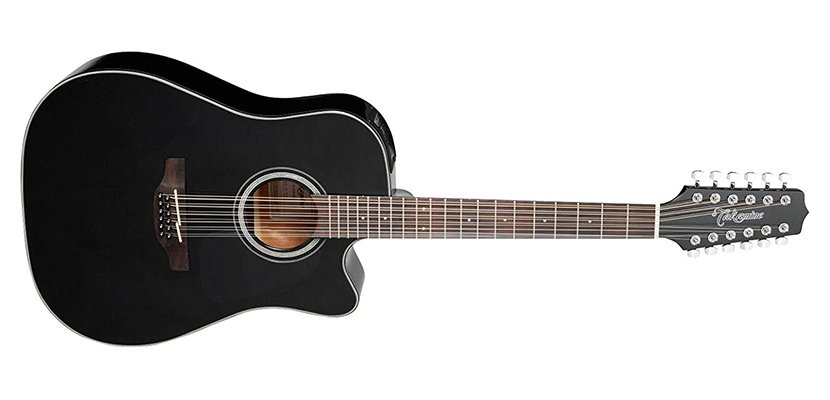
This black 12-string guitar (also available in natural) is intended to work as your reliable partner on the stage during live performance. It features a dreadnought body with Venetian-style cutaway which will let you reach the highest frets with ease. The guitar has a glossy finish. The back, neck, and sides are made of mahogany which adds an enhanced, detailed bass to your sound. The top is constructed of a solid spruce thanks to which the mid and high tones are very pronounced, and the overall sound is clearer.
The fingerboard, headcap, and bridge are manufactured of a high-quality dark rosewood. The guitar features a quartersawn X-bracing which makes it resistant to damage. The nut and saddle are made of synthetic bone nut (it’s among the most solid synthetic materials) that adds some warmth to your tones.
Overall, such construction does its job in providing rich and resonant sound very well. As for me, it sounds better in the acoustic setting, offering a broader tonal range.
Being an electric-acoustic guitar, this Takamine 12-string model features a number of controls on top of the side panel. There are 3 sliders to control the bass, middle, and treble and a knob to adjust gain which give you good universality. The Takamine electronics and TP-4TD preamp system aren’t among the strongest but will still amplify your performance quite well.
Pros
- The two-piece saddle improves the guitar’s intonation.
- The guitar comes with braces and sound that are finely tuned by hand.
- It has a soft vintage tone which is great for songwriting and intimate playing.
Cons
- The low battery indicator blinks for no reason at times.
- The guitar produces some buzzing sound sometimes.
Epiphone DR-212
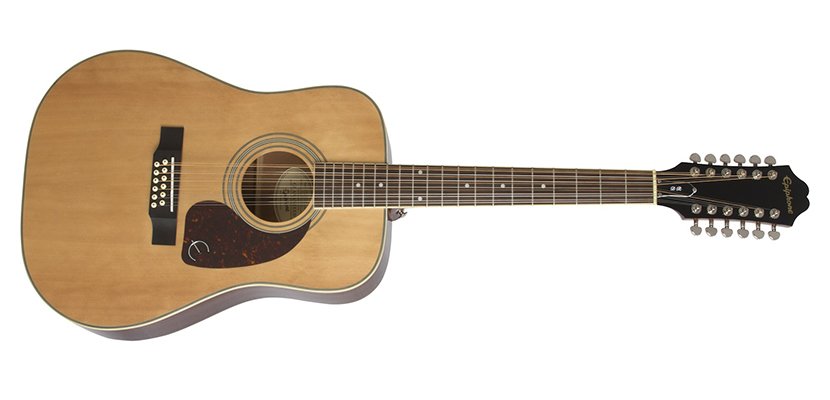
The present acoustic guitar is a 12-string version from the Epiphone’s super-popular DR guitar’s line. It has classic look with light-shade wood color and non-laminated satin finish which is very pleasant to touch and doesn’t provide any sort of slippery feel. The instrument features a dreadnought-style mahogany body (back, sides, and neck) which creates warm tones, rosewood fretboard, and spruce top.
This Epiphone 12-string guitar has scalloped bracing which makes the playing process easier and more convenient. Both the body and the neck feature ivoroid binding. Thanks to the tapered neck, the playing process is easier. The neck, however, feels a bit heavy in hand, but, overall, the build quality seems good and stable. The nut and saddle are made of sturdy plastic which provides quite a good effect on sound and playability.
In terms of sounding, the DR-212 DR-212 sounds like you would expect from a medium quality guitar. When the chords are paired in the octave, each of them sounds open. The sound is rich and strong enough. Thus, you are going to feel great when using this guitar for developing your own playing style and realizing your musical ideas.
If you want to improve the guitar’s sound quality, I would recommend replacing the stock strings with some set of higher quality. The action isn’t great out of the box but decent.
Pros
- The guitar has a balanced, cutting tone which makes it universal for such genres as blues, folk, rock, etc.
- The D-shaped neck offers better stability.
- The scalloped bracing allows for improved sound accuracy.
Cons
- It will require some time to set the guitar’s intonation out of the box.
- The guitar doesn’t have pickup, preamp, or tuner, so it may require frequent tuning.
Video Epiphone DR-212
Oscar Schmidt OD312
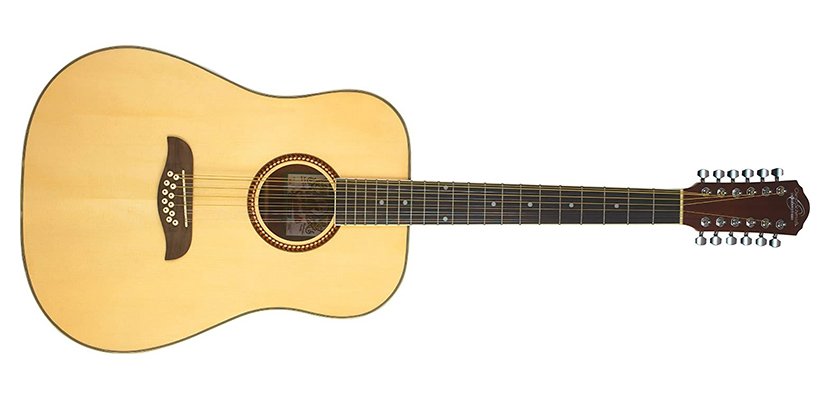
Despite the fact that such guitars are generally considered as expensive ones, the OD312 is a cheap 12-string guitar which makes it a great solution for musicians on a budget. However, this model is decently built, so you won’t have to worry about its quality. It has rosewood fingerboard and bridge, mahogany sides and back, spruce top, and even nubone nut. It may be surprising, but such materials are used in the manufacturing of Oscar Schmidt’s more expensive models.
With such a design, the guitar easily handles tension caused by the strings and will probably serve for years. In terms of the guitar’s appearance, it has a natural glossy wood finish and decorative wood marquetry which gives it a classic, professional look.
The sealed tuners and fully adjustable truss rod make this guitar easier to use and provide more accurate tuning for various playing styles. This way, it may work well for beginner and intermediate guitar players.
The sound quality appears to be resonant, and thanks to the dreadnought-style body, the overall guitar’s tone is very warm.
Pros
- The guitar comes well-adjusted.
- The manufacturer claims to provide a lifetime warranty for this guitar.
- The Barcus Berry preamp will enhance your live performance.
Cons
- The bridge is easy to scratch.
- The strings aren’t of good quality and will probably require replacement.
Takamine GJ72CE-12NAT
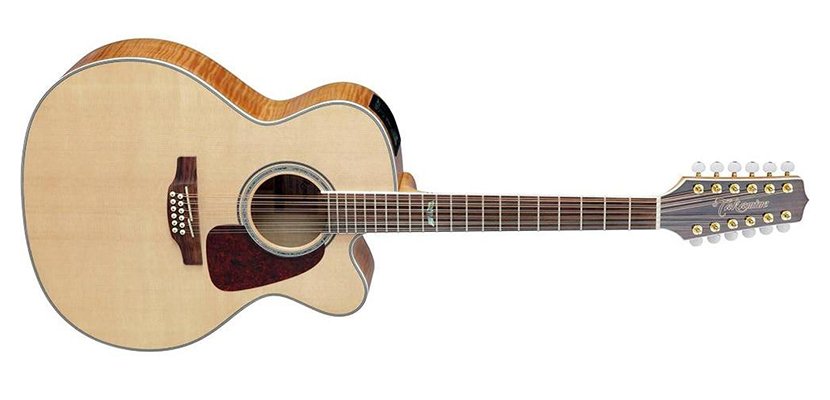
The GJ72CE-12NAT is a 12-string electric-acoustic guitar with a jumbo body, offered in two colors: natural wood and brown sunburst. Most of its body is made of flame maple (back and sides), except for the top which is made of spruce and the rosewood fingerboard. The nut and saddle are made of a synthetic bone nut.
When used as an electric 12-string guitar, the GJ72CE-12NAT has a lot of features to offer. It uses a premium-quality TK-40D preamp system with a built-in tuner and has a multifunctional control panel on the top of the right side. There you will find a three-band EQ control, gain adjustment knob, notch filter, and even bypass switching. This way, you won’t have to worry about this guitar’s versatility. The sound, produced by the GJ72CE-12NAT, can be described as rich and even lush. Plus, it reacts to the lightest touches.
Pros
- The maple construction gives strong treble.
- The hardware and tuners have a solid gold-plated finish.
- The guitar goes with high-quality D’Addario bronze strings coated with a phosphor which are perfectly suitable for live performances.
Cons
- It doesn’t work as good as an acoustic guitar as it does as an electric guitar.
- By default, the action is very low which may be a problem for those who have a heavy hand.
Video Takamine GJ72CE-12NAT
Buyer’s Guide
Things You Need to Consider Choosing a 12-String Guitar
The 12-string guitars have a unique sound that can’t be compared to any other guitars. They offer dimensional sounding and even can create the effect of two guitars playing together. However, what defines them?
Firstly, the 12-string guitars sound a bit quieter than their 6-string analogs and will require from you better accuracy when pressing the strings. Such guitars always feature large dimensions. Usually, they have standard construction and differ from the other guitars only by the number of strings, neck width, and structural strength since the tension of 12 strings is very strong and puts a significant strain on the neck and upper deck. For this reason, they almost always go with strong steel strings. This way, due to reinforced construction, these guitars are more expensive than others.
Type of Woods
The type of wood used in the manufacturing of the guitar’s body defines the quality of overall tone, sound, and resonance of the instrument (that is why it is also called “tonewood”). Each type possesses its own unique sounding.
Let’s start with the expensive models. Usually, the top part of their bodies is made of spruce or cedar. The spruce sounds sonorous but is very fragile, so it’s always coated with a thick layer of varnish. The cedar is more sturdy and produces a softer tone.
Commonly, the sides are cut from mahogany or maple/ash in rarer cases. The mahogany decreases the guitar’s weight and features a uniform structure and a big number of pores which cause a positive impact on the middle frequencies. The maple produces brighter sound, being suitable for soft rock/blues players. The ash is popular for its hardness and density which contribute to the brighter tone and longer sustain.
As an alternative to wood, some manufacturers make their guitars of nano-materials, like resin-impregnated silicone fiber. Such an innovative approach allows you to change the guitar’s resonance by heating it up, for example.
Body Shape
The 12-string guitars are made on the basis of reinforced dreadnought and jumbo bodies. They are remarkable for having a wider waist than any other usual guitar. Of course, there are other shapes as well, but this one is the most common one as it allows for louder sound and smoother tone.
Some models have cutaways that let your left hand reach the highest frets with ease. It doesn’t influence the sound too much, but some amount of resonance can be lost. In general, both the face and back panels of the instrument are flat. Sometimes, they may be slightly curved which allows changing the tone a bit.
Neck
The neck of a twelve-string guitar is usually wide and thick. The C-shaped necks that are slightly flat in the center are the most common ones. The D-shaped necks are fatter and rounder. The flatter necks are more melodic while those that are rounder make it easier to play chords.
The necks are usually made of mahogany or maple, and since even cheap guitars have steel truss rods inside to make the neck more durable, it’s hard to say which wood is better in this ace.
The rosewood is usually used in the manufacturing of the fingerboard. Recently, there is also a tendency to use laurel or purpleheart. All of these types are equally good, as for me, and it’s more a case of aesthetic which one to choose. Fingerboards are usually slightly rounded, the level of bend usually varies from 12 to 15 inches.
Scale lengths
The length of the scale means the string length starting from the nut and up to the bridge. The most common length is 25 inches. The longer the scale is, the further the frets are located from each other. The long scale also means that the strings are tensioned stronger which allows for a brighter tone.
The models with 12 strings usually have from 20 to 21 frets. It’s easier to play guitar with higher frets if its scale is long. However, the difference is very subtle and will not have a significant impact on your choice. The more important thing is to ensure that the fret ends are located on the same level and are polished evenly and smoothly. The neck sides may be made of plastic, but that is not a problem.
Electronics
Most 12-string guitars have a piezo pickup, integrated into the bridge. Usually, the knobs on the preamps allow you to control the volume level, tune the treble, adjust the amount of bass. Most of them also have an electronic tuner. More rarely, you can find models endowed with gain and frequency range controls.

Hi everyone! I’m Thomas Moody, also known as Guitarzan.
